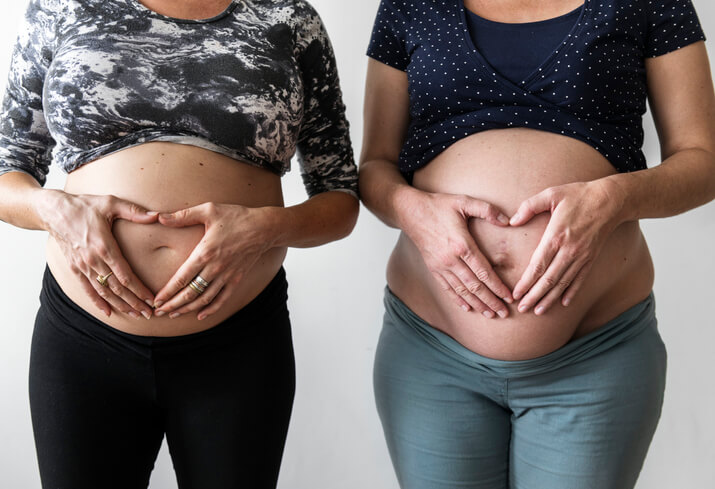As you consider your medical options for surrogacy, you may have heard one phrase pop up: “dual embryo transfer.”
If you’re an intended parent, the promise of a dual transfer may seem exciting. But, there are a few things to know before you decide to take this path.
Below, find out a bit more about this medical option. Remember, our surrogacy specialists are always available to answer your questions, as well.
Keep in mind: In this blog post, “dual transfer” and “double-embryo transfer” are two separate things. Read more about the latter here.
What is a Dual Transfer, and Why Do People Choose this Option?
A dual transfer occurs when both a gestational carrier and her intended mother undergo an embryo transfer at the same time. Usually, it’s a way for an intended mother to have one more chance at getting pregnant. It also sets up the possibility that both women will experience pregnancy together.
While there are no official statistics on dual transfers in gestational surrogacy, it’s reasonable to assume that this occurrence is fairly rare. After all, many intended mothers come to surrogacy after failed IVF attempts; that’s why they’ve chosen someone else to carry their child for them.
For the women with the means to do so, however, dual transfers are one final way they can try to become pregnant and carry their own child. This can be a complicated process, though, so it’s only one to be pursued after much discussion with surrogacy and medical professionals — not to mention a prospective surrogate.
What are the Pros and Cons of a Dual Transfer?
The decision to pursue a dual transfer should only be made after intended parents and their gestational carrier have talked at length about it. The worst thing you can do is surprise your gestational carrier on embryo transfer day when you get prepped for the procedure, too.
As you discuss the possibility of dual embryo transfer with your prospective surrogate, refer to these advantages and disadvantages:
Pros:
- There is a higher chance of a successful pregnancy. Looking solely at numbers, having both a gestational carrier and an intended mother undergo an embryo transfer increases the chance that there will be a successful pregnancy. However, if a reproductive endocrinologist has determined that an intended mother is highly unlikely to become pregnant, a dual transfer may not increase the overall chances of pregnancy that much.
- An intended mother gets another shot at carrying her own child. If an intended mother has unexplained fertility or a doctor has determined she may be able to get pregnant, a dual transfer gives her one more chance at becoming pregnant. In this way, she can pursue her own pregnancy dreams with the simultaneous “backup” that her gestational carrier may become pregnant instead.
- There are fewer “leftover” embryos. One of the biggest questions for intended parents is what to do with their remaining embryos. It can be emotionally difficult to discard or donate them, but frozen storage is not a permanent solution. If an intended mother undergoes an embryo transfer, she may feel like she “used” all of her embryos, even if a pregnancy does not result.
Cons:
- Dual transfers are emotionally complicated. If an intended mother is interested in a dual transfer, it’s usually because she has not properly grieved the loss of the pregnancy experience. In the best case scenario, she gets pregnant during her dual transfer — but what if she doesn’t? She may be devastated by another failed pregnancy, and her emotions will likely be compounded if her gestational carrier becomes pregnant. What should be a happy time will be a sad one — not a wonderful start to their partnership together.
- Dual transfers will cost more. It seems obvious, but just because you are doing two transfers at the same time doesn’t mean you will get two-for-one pricing. And, with the average IVF cycle costing $12,000, an intended mother is looking at a huge increase to her overall surrogacy costs.
- Many surrogates will not agree to a dual transfer. Intended mothers who are thinking about a dual transfer should be upfront with their surrogate about their desires — before even signing the legal contract. Ideally, your plans to do a dual transfer should be a part of your initial search for a surrogate. Many women will not be comfortable with the complexities and unknowns of carrying a pregnancy at the same time as their intended mother, so it may be harder for you to find a surrogate with whom to take this path.
- Intended parents can get more than they bargain for. Those who consider dual transfers often don’t consider the possibility of both transfers being successful — but it can happen. Are you prepared to care for two babies if so? Or four, if you both receive a double-embryo transfer?
Choosing to move forward with a dual transfer is a highly personal decision — but it is one that must be approved by your reproductive endocrinologist and your surrogacy professional. To talk to one of our surrogacy specialists about our agency policies on this and other procedures, please call us at 1-800-875-2229(BABY) or contact us online.
